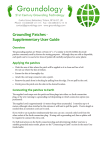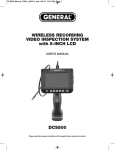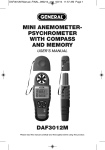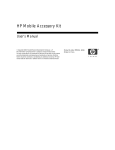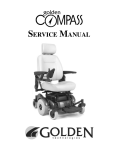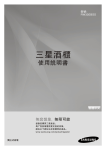Download The PalmScope™ COMPACT RUGGED VIDEO
Transcript
The PalmScope™ COMPACT RUGGED VIDEO INSPECTION SYSTEM USER’S MANUAL PCS55 Please read this manual carefully and thoroughly before using this product. TABLE OF CONTENTS Introduction . . . . . . . . . . . . 3 – 4 Key Features . . . . . . . . . . . . . . . 5 Safety Instructions . . . . . . . 5 – 6 What’s in the Package . . . . 5 – 6 Product Overview . . . . . . . . 6 – 9 Setup Instructions . . . . . . 9 – 16 Install Batteries . . . . . . . . . . . 9 Prepare the Probe . . . . 10– 15 Attach Thread Protector or Accessory . . . . . . . 15 – 16 Operating Instructions . . 16 – 18 Quick Start Procedure . 16 – 18 Specifications . . . . . . . . . . . . . 19 Maintenance Tips . . . . . . . . . . 20 Warranty Information . . . 21 – 22 Return for Repair Policy . 22 – 23 2 INTRODUCTION Thank you for purchasing General Tools & Instruments’ PCS55 Compact Rugged Video Inspection System (The PalmScope™). Please read this user’s manual carefully and thoroughly before using the instrument. The PalmScope is more than just the smallest full-featured video inspection system available today. It is also built to survive in the harsh environments of plumbing and automotive maintenance and repair—not to mention any unusual situations a do-it-yourselfer might subject it to. The unit’s thermoplastic rubber (TPR) housing and integral LCD are certified “drop-proof” to a height of 1m (3.4 ft.). The system can be operated with one hand, leaving the other hand free to use tools. The grip and LCD get their input from a camera-tipped probe. The probe that comes with the PalmScope is 2 ft. (0.6m) long and has a camera-head diameter of 9mm (0.35 in.), making it ideal for inspecting gasoline engine cylinders through the spark plug hole. 3 Other general automotive applications include inspecting hard-to-reach or hard-to-see areas of the engine compartment or undercarriage. The PalmScope has only five control buttons (power on/off, brightness up, brightness down, video zoom, and video flip), making it very easy to learn to use. Video within the probe’s field of view is displayed on a high-quality 2.4 in. (61mm) diagonal color LCD. The video zoom and flip functions make The PalmScope an even more valuable inspection tool. Doubling the size of any component in the video frame makes it less likely that any problem will be overlooked. The reason to invert video is to align the probe’s field of view with its real-world surroundings; in practical terms, this function makes it easier to read upside-down labels and serial numbers by flipping them right-side up. The PalmScope includes four accessories sized for the tip of the 9mm probe: a 45° mirror, a pickup hook, a magnetic pickup, and a metal ring (to protect the threads of the probe from damage). 4 KEY FEATURES • Fits in your pocket or clips to your belt • Probe coils inside case for storage • Drop-proof from height of 1m (39 in.) • Long, flexible-obedient probe with 9mm diameter camera head penetrates tight, hard-to-reach spaces • 2.7 in. (686mm) high contrast color LCD • Four camera-lighting LEDs produce bright, crisp video • Four screen controls for brightness, 1 to 4X zoom, 180° image flip • Powered by four “AAA” batteries • On-screen low battery icon • CE and RoHS approved • 1 year limited warranty SAFETY INSTRUCTIONS Do not use The PalmScope to inspect environments known or suspected to contain exposed electrical wiring. Do not use it in the presence of flammable or explosive gases. 5 Never use the system to perform medical inspections. WHAT’S IN THE PACKAGE The PalmScope and its accessories come in a blister pack. In addition to the instrument, the package contains: • A plastic bag containing the four probe tip accessories: the 45° mirror, pickup hook, magnetic pickup, and thread protector • A nylon pouch with a belt clip • This user’s manual PRODUCT OVERVIEW Fig. 1 shows The PalmScope and its accessories. Fig. 2 shows the positions of its display, controls and physical structures. Familiarize yourself with their names and functions before moving on to the Setup Instructions and Operating Instructions. 6 Fig. 1. The PalmScope, the four probe tip accessories, and the nylon pouch with belt clip Inside the pouch is a small plastic bag containing the following probe tip accessories: A. Pickup hook B. 45° mirror C. Magnetic pickup D. Thread protector 7 Fig. 2. The controls, indicators and back of The PalmScope A. LCD B. button. Increases brightness of LED lights C. button. Inverts video 180° D. button. Powers unit on and off E. button. Enlarges video frame up to 4X. Each button press increases zoom level by factor of 0.5 F. button. Decreases brightness of 4 camera LED lights G. Lanyard attachment bar H. Lens cap I. Camera head J. Flexible-obedient probe K. Probe exit port 8 L. Clamshell latches M. Battery compartment N. Battery compartment screws K N L M SETUP INSTRUCTIONS INSTALL BATTERIES The PalmScope’s battery compartment (Fig. 2, Callout M) is accessible from the back of the unit. To install batteries, Use a Phillips-head screwdriver to loosen the two screws securing the battery compartment cover (Fig. 2, Callout N). Remove the cover and set it aside. Load four “AAA” batteries into the compartment, using the polarity markings within it as a guide Replace the battery compartment cover and secure it by tightening the Phillipshead screws. 9 PREPARE THE PROBE To gain access to the probe, flip the PalmScope over so its back faces you, place your thumb and index finger at the positions marked OPEN (Fig. 2, Callout L), and gently squeeze the latches (see figure above). The clamshell case will pop open. Note that the probe is tightly wrapped within a twisting channel that makes two full turns around the inside of the clamshell. The probe can be uncoiled to either of two working lengths (see photos at top of next page). Unwrapping only one full turn will make the probe 12.5 in. long. Unwrapping both turns will make the probe 24 in. long. 10 Each length incurs a tradeoff of probe reach vs. probe rigidity. A longer probe is obviously better for inspecting distant objects. But when uncoiled to its maximum length of 24 in., the probe sags from its own weight, preventing it from being extended horizontally. If the 12.5 in. length is sufficient to reach most of your inspection targets, select that shorter length; at 12.5 in., the probe is light enough at 12.5 in. long to be extended horizontally. Whichever probe length you choose, before you can use the unit you must re-coil the unextended section of probe within the channel inside the clamshell and then squeeze the clamshell shut. To protect the internals of the unit from being damaged by a fall, an electrical interlock prevents The PalmScope from being powered on with the clamshell open. 11 To re-coil the probe, begin by holding the unit in front of you as shown in the first photo of the sequence below. Take care that the lanyard does not accidentally get tangled up with the probe as you coil it. If you chose the shorter probe length, you will not have to wrap the unextended probe section at all. All you must do is make sure to wrap that section within the part of the internal channel nearer the front of the unit. 12 Before squeezing the two halves of the clamshell together to close it, check that the entire length of the probe section inside the clamshell is within the channel and that the camera head (the thicker end of the probe) is within both semicircular sections of the top of the housing comprising the probe’s exit port (Fig. 2, Callout K). Finally, squeeze the two halves of the clamshell together to close it. The clamshell is not properly closed until you hear the latches snap. If you chose the longer probe length, you will have to wrap a long section of probe within two turns of the channel inside the clamshell (see sequence of six photos beginning below). 13 For this reason it is especially important that the probe is wrapped tightly and remains within the helical channel without “crossing over” the channel boundaries. Before squeezing the two halves of the clamshell together to close it, check that the entire probe is within the channel and that the camera head is within both semicircular sections of the exit port. Finally, squeeze the two halves of the clamshell together to close it. The 14 clamshell is not properly closed until you hear the latches snap. It’s important to note that when recoiling the probe from either its short or long extended length, you must wrap it very tightly within the channel. If the camera head has not cleared the probe exit port as you finish wrapping the probe (see photo at right), you will not be able to squeeze the clamshell shut. You must start over. ATTACH THREAD PROTECTOR OR ACCESSORY The PalmScope comes with four accessories that screw onto the cameratipped end of the probe. Each accessory has a specific purpose: • The 45° mirror lets the probe see around corners. • The pickup hook lets you retrieve otherwise inaccessible items seen by the probe—for example, a wedding ring accidentally dropped down a sink drain. 15 • The magnetic pickup lets you retrieve lost or dropped metal objects—nuts and bolts, for example—located by the probe. • The thread protector keeps the camera head and its threads from being scratched or damaged by anything the probe bumps into. Attach the thread protector before you use The PalmScope for the first time. Remove it before attaching any of the three other accessories. Reattach the thread protector after removing an accessory. Never expose the threads of the probe tip to the dangers of an inspection session. OPERATING INSTRUCTIONS QUICK START PROCEDURE 1. Before you use the PalmScope for the first time, carefully peel off and discard the plastic film protecting the LCD. 2. Remove the black rubber lens cap (Fig. 2, Callout H) from the end of the probe. 16 3. Press and hold the button (Fig. 2, Callout D) for at least 3 seconds to power on the unit and illuminate the LCD. 4. Point the camera-tipped end of the probe at the target of interest, pushing the probe through holes or bending the probe around objects if necessary. Avoid bending the delicate probe excessively; this will damage it. 5. Press the button (Fig. 2, Callout B) to increase the brightness of the camera’s LEDs 6. Press the button (Fig. 2, Callout F) to decrease the LEDs’ brightness 7. Press the button (Fig. 2, Callout C) to flip the video (rotate it 180°). Press the button again to undo the inversion. Use the arrow stenciled on the camera head to orient video up and down (for example, to read text or serial numbers). 8. Press the button to enlarge the video frame. The first press of the button enlarges the frame 50%, corresponding to a zoom level of 1.5X. “X 1.5” will appear in light blue at the 17 bottom right of the screen. Push the button several times to zoom in closer at a level of 2.0X, 2.5X, 3.0X, 3.5X and 4.0X. The next push of the button reverts to normal size (1X) viewing. To power off The PalmScope, press and hold the button for at least 3 seconds. The PalmScope is designed to be powered for several hours by the same set of four “AAA” batteries. A (low battery) icon will appear on-screen when the total battery charge drops below an operational threshold. To replace the batteries, follow the procedure on p. 10 of this manual. 18 SPECIFICATIONS Display Size/Type: 2.7 in. (686mm) diagonal TFT color LCD Display Resolution: 320 x 240 pixels Monitor Controls: 180° flip, 1X to 4X zoom in 6 steps, brightness + and – Camera Head Diameter: 9mm (0.35 in.) Probe Length & Type: 2 ft. (0.6m) flexible-obedient Camera Field of View: 60° Camera Depth of Field: 1 in. (25mm) to 10 ft. (25mm to 3m) Camera Light Source: 4 adjustablebrightness white LEDs Impact Resistance: From height of 1m (39 in.) Probe/Camera Head Water & Dust Resistance Level: IP67 Battery Life: >3 hours (typical) Operating Temperature/Humidity: 32° to 113°F (0° to 45°C) @ 5 to 95% RH Dimensions: 5.4 x 2.9 x 1.5 in. (136 x 73 x 39mm) Weight of Grip: 9 oz. (250g) Power Source: Four “AAA” batteries 19 MAINTENANCE TIPS • The camera at the tip of the probe is a sensitive, sophisticated device. Do not use the probe as a hammer or to clear debris. • Do not insert or bend the probe by force. Over-bending any section of the probe to a radius of less than 2 in. (50mm) many permanently damage delicate internal cables. • Remember to power off The PalmScope after each inspection session. • Do not get water on the LCD. • Do not bring the camera into contact with acid, fire or hot objects by using the probe in a corrosive or extremely hot environment. • Avoid getting oil or gas on the camera head by shutting off vehicles during inspections. • If condensation forms inside the camera lens, let it evaporate before using the system again. • Remove the batteries if planning to store the unit for months or longer. 20 WARRANTY INFORMATION General Tools & Instruments’ (General’s) PCS55 (The PalmScope) Compact Rugged Video Inspection System is warranted to the original purchaser to be free from defects in material and workmanship for a period of one year. Subject to certain restrictions, General will repair or replace this instrument if, after examination, the company determines it to be defective in material or workmanship. The warranty period begins on the date of purchase. You are encouraged to register your product online. General will extend your warranty an additional 60 days if you register at www.generaltools.com/ProductRegistry. This warranty does not apply to damages that General determines to be from an attempted repair by nonauthorized personnel or misuse, alterations, normal wear and tear, or accidental damage. The defective unit must be returned to General Tools & Instruments or to a General-authorized service center, freight prepaid and insured. 21 Acceptance of the exclusive repair and replacement remedies described herein is a condition of the contract for purchase of this product. In no event shall General be liable for any incidental, special, consequential or punitive damages, or for any cost, attorneys’ fees, expenses, or losses alleged to be a consequence of damage due to failure of, or defect in any product including, but not limited to, any claims for loss of profits. Register now at www.generaltools.com/ProductRegistry to receive a 60-day extension to your warranty. RETURN FOR REPAIR POLICY Every effort has been made to provide you with a reliable product of superior quality. However, in the event your instrument requires repair, please contact our Customer Service to obtain an RGA (Return Goods Authorization) number before forwarding the unit via 22 prepaid freight to the attention of our Service Center at this address: General Tools & Instruments 80 White Street New York, NY 10013 212-431-6100 Remember to include a copy of your proof of purchase, your return address, and your phone number and/or e-mail address. 23 GENERAL TOOLS & INSTRUMENTS 80 White Street New York, NY 10013-3567 PHONE (212) 431-6100 FAX (212) 431-6499 TOLL FREE (800) 697-8665 e-mail: [email protected] www.generaltools.com PCS55 User’s Manual Specifications subject to change without notice ©2013 GENERAL TOOLS & INSTRUMENTS NOTICE - WE ARE NOT RESPONSIBLE FOR TYPOGRAPHICAL ERRORS. MAN# PCS55 10/28/13
























